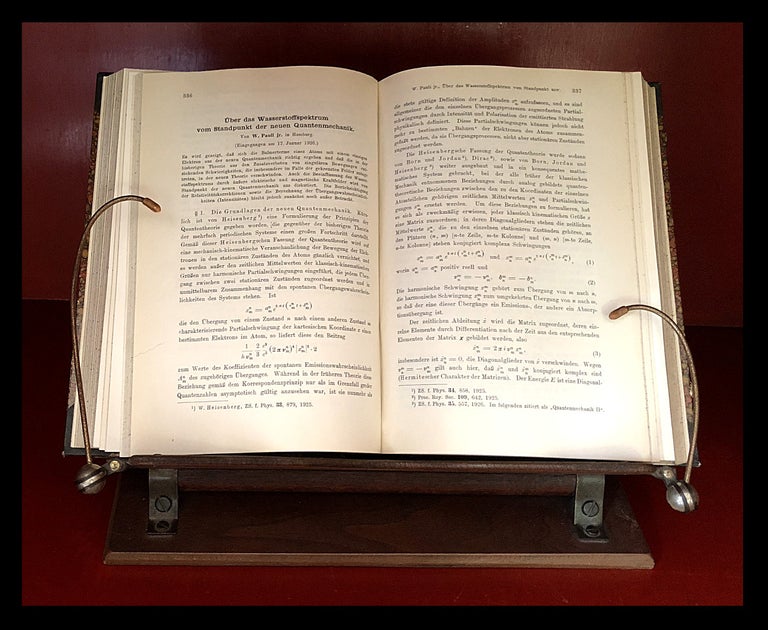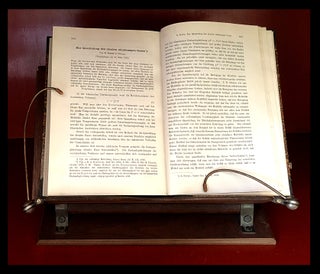Uber das Wasserstoffspektrum vom Standpunkt der neuen Quantenmechanik (Pauli, pp. 336-363) WITH Zur Quantelung des Idealen Einatomigen Gases (Fermi, pp. 902-912) WITH Zur Deutung einiger Erscheinungen in den Molekelspektren (Hund, pp. 657-674) in Zeitschrift fur Physik 36, 1926
Berlin: Julius Springer, 1926. 1st Edition. FIRST EDITION, FULL VOLUME, COMPLETE WITH 3 IMPORTANT PAPERS. THE FIRST, PAULI’S, IS THE 1st SIGNIFICANT APPLICATION OF & 1ST VALIDATION OF HEISENBERG’S NEW QUANTUM MECHANICS. Very good+. Upon publication, Max Born said Pauli’s derivation of the hydrogen spectrum from the new quantum mechanics proved “there was no longer any doubt about the correctness of the theory among physicists” (Born, Physics in My Generation, p. 181).
ALSO: Fermi’s paper proposes Fermi-Dirac statistics, “a set of equations describing the distribution of energies of a system of identical particles (e.g., electrons) that obey the exclusion principle” (History of Physics, The Wenner Collection). ALSO: An early paper by Hund “marking his debut” in “[appealing] to molecular spectroscopy in order to introduce the concept of molecular orbital [theory] – an important step in the “genesis of the quantum theory of the chemical bond” (Gavroglou, Quantum Chemistry, 34; Advances in Historical Studies, 3, 5, 2014). PAULI: In 1925, Heisenberg’s stunned the world with “the first successful formulation of the new quantum theory, now called “quantum mechanics” (Wenner). A Noble Prize winning paper [in ZfP, 33, 1925 and which we offer separately] Heisenberg’s theory was “formulated in terms of matrix equations… [it predicted] the nature of the radiation resulting from electron state transitions between energy shells in the atom… [more simply, it] “was based only on what can be observed, that is to say, on the radiation emitted by the atom” (DSB; Nobel Prize Committee). A few months later and in this paper, Pauli “calculated the stationary energy values of the hydrogen atom using [Heisenberg’s] matrix method” – in other words, by the new quantum mechanics; in so doing he provided the first validation of Heisenberg’s theory. Via this method, Pauli provided “the first nontrivial and physically important application of [Heisenberg’s] quantum mechanics” – its first proof and a clear validation of its superiority over the old quantum mechanics of Bohr” (Born). As Pauli himself wrote in the abstract: “ It is shown that the Balmer terms of an atom with a single electron are yielded correctly by the new quantum mechanics and that the difficulties which arose in the old theory disappear in the new theory” (Pauli, 1926).
FERMI: Fermi’s paper presenting ‘Fermi-Dirac statistics’ is an “important outgrowth of Pauli’s exclusion principle” (Wenner). Fermi-Dirac statistics are a “set of equations describing the distribution of energies of a system of identical particles (e.g., electrons) that obey the exclusion principle. These statistics explain how metals and semiconductors conduct electricity, why some substances are hard and others not, and how astronomical objects such as neutron stars avoid collapse into black holes. Fermi and Dirac independently proposed the Fermi–Dirac statistics in 1926” [we offer the Dirac paper separately]. Published initially in Italian (in the same year), this ZfP publication is longer and considered the more complete.
HUND: Though sometimes overshadowed by his 1927 paper [which we offer separately in Zfp 40], the 1926 Hund paper offered here is “a seminal work” and “a key contribution [in molecular spectroscopy] derived from the atomic” (Esposito). Hund discusses “the nature of molecular electronic states from a theoretical point of view, introducing electron spin into band structure AND presents “a method for determining molecular structure in which electrons are not assigned to individual bonds between atoms, but are treated as moving under the influence of the nuclei in the whole molecule” (Socratic Portal). Item #1099
CONDITION: Complete volume. 8vo. (9 x 6.5; 225 x 163mm). pp. 951. One stamp appears on the title page. Bound in black cloth over marbled paper hardboard; gilt-lettered at the spine. Very slight scuffing at the edges. Tightly bound (and professionally reinforced within). The interior is clean and bright. Very good + condition.
Price: $575.00



